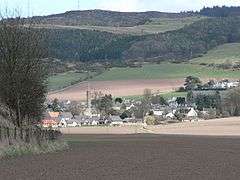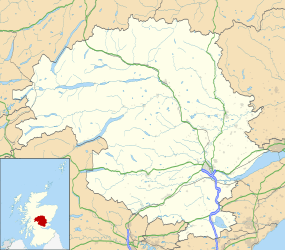Abernethy, Perth and Kinross
| Abernethy | |
| Scottish Gaelic: Obar Neithich | |
 The village of Abernethy |
|
 Abernethy |
|
| Population | 945 [1] (2001 census) est. 1,350[2] (2006) |
|---|---|
| OS grid reference | NO189163 |
| Council area | Perth and Kinross |
| Lieutenancy area | Perth and Kinross |
| Country | Scotland |
| Sovereign state | United Kingdom |
| Post town | PERTH |
| Postcode district | PH2 9xx |
| Dialling code | 01738 85 |
| Police | Scottish |
| Fire | Scottish |
| Ambulance | Scottish |
| EU Parliament | Scotland |
| UK Parliament | Ochil and South Perthshire |
| Scottish Parliament | Perthshire South and Kinross-shire |
Coordinates: 56°19′59″N 3°18′42″W / 56.33302°N 3.31163°W
Abernethy (Scottish Gaelic: Obar Neithich) is a village in Perth and Kinross, Scotland, situated 8 mi (13 km) south-east of Perth. It has one of Scotland's two surviving Irish-style round towers (the other is at Brechin, Angus; both are in the care of Historic Environment Scotland). The tower stands 74 ft (23 m) high, and it is possible to climb to the top, using a modern metal spiral staircase (the tower originally had several wooden floors linked by ladders). The tower was evidently built in two stages (shown by a change in the masonry), and probably dates to the 11th-early 12th centuries.[3]
The village was once the "capital" (or at least a major religious and political centre) of the kingdom of the Picts.[4] The parish church, which sits on land given by Nechtan,a king of the Picts, is dedicated to Saint Brigid of Kildare of (fl. 451-525), and the church is said to have been founded by Dairlugdach, second abbess of Kildare, one of early Christian Ireland's major monasteries.
Abernethy is believed to have been the seat of an early Pictish bishopric, its diocese extending westward along Strathearn. In the 12th century the bishop's seat was moved to Muthill, then Dunblane, so that Abernethy, no longer being a residential bishopric is today listed by the Catholic Church as a titular see.[5]
Abernethy remained the site of a small priory of Augustinian canons, founded 1272. In the 15th century, this priory was suppressed in favour of a collegiate church under the patronage of the Douglas Earls of Angus. Remains of the collegiate church survived until 1802 within the present village graveyard, when they were replaced by the present plain red sandstone church, which is still dedicated to Saint Brigid.[6]
The village's name is Celtic, meaning 'confluence of the Nethy' (i.e. with the River Tay), the earliest recorded form being Apurnethige. The Nethy Burn flows down from the Ochil Hills past the present village. Several pieces of Pictish or early medieval sculpture have been found in Abernethy, including an incomplete Pictish symbol stone attached to the base of the round tower. The location "Afarnach's Hall" referred to in the earliest mediaeval Arthurian literature is usually identified as Abernethy.
The small but well stocked museum, open 2pm to 5pm from Wednesday to Sunday between May and September, has exhibits on the history of the village and also holds a key to the tower.[7][8]
Over the years local industry and commerce has largely declined. A general store is the only shop remaining on the Main Street (the post office having closed in early 2009). However, the village still manages to support two local pubs and a tea room (which also holds a tower key). A mobile post office also visits the village most weekdays.
A Gala / Fete Day is held annually on the first or second Saturday in June, with a race to the top of nearby Castle Law taking place the following day.
Notes
- 1.^ The foundation of Abernethy is to be found in the Pictish Chronicle and links it to Nechtan Morbet. However, it may have been Nechtan nepos Uerb, and the later Nechtan mac Der-Ilei may have been confused with the previous two.
References
| Wikisource has the text of the 1921 Collier's Encyclopedia article Abernethy. |
- ↑ "Comparative Population Profile: Abernethy Locality". Scotland's Census Results Online. 2001-04-29. Retrieved 2008-08-31.
- ↑ General Register Office for Scotland
- ↑ Abernethy Round Tower at Historic Scotland
- ↑ Abernethy Archived 13 October 2009 at the Wayback Machine. at the Museum of Abernethy
- ↑ Annuario Pontificio 2013 (Libreria Editrice Vaticana 2013 ISBN 978-88-209-9070-1), p. 821
- ↑ Annuario Pontificio 2013 (Libreria Editrice Vaticana 2013 ISBN 978-88-209-9070-1), p. 821
- ↑ Opening times Archived 12 October 2009 at the Wayback Machine.
- ↑ Museum of Abernathy
| Wikimedia Commons has media related to Abernethy, Perth and Kinross. |